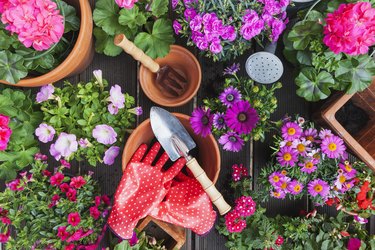
When it comes to Indiana flower gardens, there are many annual and perennial species from which to choose. The ideal planting time for flowers in Indiana depends on a few factors, including where in the state the garden is located and the kind of flowers you are growing. When choosing perennials for your Indiana flower garden, keep in mind that most of the state falls within U.S. Department of Agriculture plant hardiness zone 6, while some parts of the state are in zones 5 or 7.
Annuals for Indiana Flower Gardens
Video of the Day
Annual flowers are those that live for a single growing season. Marigolds and zinnias are examples of annual plants. Whether you are growing these plants from seeds started indoors or by purchasing seedlings from a nursery, the key is waiting until frost is no longer a concern before transplanting annuals into the garden.
Video of the Day
In Indiana, May is considered the best time to transplant annuals outdoors, though the timing depends on where in the state you live. In southern Indiana, you can transplant annuals in early May, while you may have to wait until late May in the northern parts of the state. If you are sowing seeds directly into the garden, you'll want to wait until soil temperatures have warmed up to 60 degrees Fahrenheit.
Growing Perennials in Indiana
Perennials, which are plants that survive for more than one growing season, may be tender or hardy. While hardy perennials can handle winter weather, tender perennials are sensitive to the cold and must often be dug up and overwintered indoors. Both tender perennials and hardy perennials can be grown in Indiana, though planting times differ for each. Tender perennials, which include tuberous begonias, dahlias and cannas, are best planted in May in Indiana.
Daylilies are popular hardy perennials in Indiana flower gardens and throughout the Midwest. The best time to plant daylilies is from late August through September. This will give the plant time to become established before winter and set flower buds for the following season. It is also possible to plant daylilies in the spring; however, flowering will likely be reduced during the first year.
Spring-Flowering Bulbs in Indiana
Tulips, daffodils and crocus are all great spring flowers for Indiana. All of these flowers grow from bulbs and should be planted in the fall in order to give them time to establish roots before the onset of winter. The ideal window for planting bulbs in this state is late September to mid-October. If you plant earlier than this, you risk the bulbs sprouting in the fall, which would be problematic because the new growth will not make it through the winter. If you wait too long to plant, however, the roots may not be developed enough to survive the cold.
There is another reason autumn is the best time to plant flowering bulbs in Indiana. By doing so, you ensure that the bulbs are exposed to temperatures between 40 and 50 degrees Fahrenheit for two to three months, which is key for the plant to set flower buds. If you plant different bulbs, you can enjoy many types of flowers in the spring.
- Purdue University Cooperative Extension Service: Autumn Time to Plant Spring Flowering Bulbs
- Purdue University Cooperative Extension Service: Growing Annual Flowers
- Purdue University Cooperative Extension Service: May Garden Calendar
- Purdue University Cooperative Extension Service: Daylilies
- Arbor Day Foundation: Hardiness Zone Map